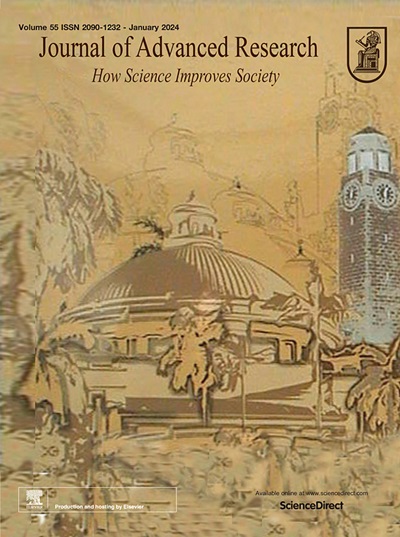Identification of a transcription factor AoMsn2 of the Hog1 signaling pathway contributes to fungal growth, development and pathogenicity in Arthrobotrys oligospora
IF 11.4
1区 综合性期刊
Q1 MULTIDISCIPLINARY SCIENCES
引用次数: 0
Abstract
Introduction
Arthrobotrys oligospora has been utilized as a model strain to study the interaction between fungi and nematodes owing to its ability to capture nematodes by developing specialized traps. A previous study showed that high-osmolarity glycerol (Hog1) signaling regulates the osmoregulation and nematocidal activity of A. oligospora. However, the function of downstream transcription factors of the Hog1 signaling in the nematode-trapping (NT) fungi remains unclear.
Objective
This study aimed to investigate the functions and potential regulatory network of AoMsn2, a downstream transcription factor of the Hog1 signaling pathway in A. oligospora.
Methods
The function of AoMsn2 was characterized using targeted gene deletion, phenotypic experiments, real-time quantitative PCR, RNA sequencing, untargeted metabolomics, and yeast two-hybrid analysis.
Results
Loss of Aomsn2 significantly enlarged and swollen the hyphae, with an increase in septa and a significant decrease in nuclei. In particular, spore yield, spore germination rate, traps, and nematode predation efficiency were remarkably decreased in the mutants. Phenotypic and transcriptomic analyses revealed that AoMsn2 is essential for fatty acid metabolism and autophagic pathways. Additionally, untargeted metabolomic analysis identified an important function of AoMsn2 in the modulation of secondary metabolites. Furtherly, we analyzed the protein interaction network of AoMsn2 based on the Kyoto Encyclopedia of Genes and Genomes pathway map and the online website STRING. Finally, Hog1 and six putative targeted proteins of AoMsn2 were identified by Y2H analysis.
Conclusion
Our study reveals that AoMsn2 plays crucial roles in the growth, conidiation, trap development, fatty acid metabolism, and secondary metabolism, as well as establishes a broad basis for understanding the regulatory mechanisms of trap morphogenesis and environmental adaptation in NT fungi.

鉴定 Hog1 信号通路的转录因子 AoMsn2 有助于寡孢子节肢动物真菌的生长、发育和致病性。
导言:寡孢子节肢动物(Arthrobotrys oligospora)能够通过开发特化的捕获器来捕获线虫,因此被用作研究真菌与线虫之间相互作用的模式菌株。先前的一项研究表明,高渗透性甘油(Hog1)信号调节寡孢子菌的渗透调节和杀线虫活性。然而,Hog1 信号转导的下游转录因子在线虫诱捕(NT)真菌中的功能仍不清楚:本研究旨在探讨寡孢子线虫 Hog1 信号通路下游转录因子 AoMsn2 的功能和潜在调控网络:方法:采用靶向基因缺失、表型实验、实时定量 PCR、RNA 测序、非靶向代谢组学和酵母双杂交分析等方法研究 AoMsn2 的功能:结果:Aomsn2缺失后,菌丝明显增大和膨胀,隔膜增加,细胞核明显减少。突变体的孢子产量、孢子萌发率、捕获率和线虫捕食效率都明显下降。表型和转录组分析表明,AoMsn2 对脂肪酸代谢和自噬途径至关重要。此外,非靶向代谢组分析还发现了 AoMsn2 在调节次生代谢产物方面的重要功能。此外,我们还根据京都基因百科全书通路图和在线网站 STRING 分析了 AoMsn2 的蛋白质相互作用网络。最后,通过Y2H分析确定了Hog1和6个AoMsn2的假定靶蛋白:我们的研究揭示了AoMsn2在NT真菌的生长、分生孢子、捕集器发育、脂肪酸代谢和次生代谢中的关键作用,并为理解NT真菌捕集器形态发生和环境适应的调控机制奠定了广泛的基础。
本文章由计算机程序翻译,如有差异,请以英文原文为准。
求助全文
约1分钟内获得全文
求助全文
来源期刊

Journal of Advanced Research
Multidisciplinary-Multidisciplinary
CiteScore
21.60
自引率
0.90%
发文量
280
审稿时长
12 weeks
期刊介绍:
Journal of Advanced Research (J. Adv. Res.) is an applied/natural sciences, peer-reviewed journal that focuses on interdisciplinary research. The journal aims to contribute to applied research and knowledge worldwide through the publication of original and high-quality research articles in the fields of Medicine, Pharmaceutical Sciences, Dentistry, Physical Therapy, Veterinary Medicine, and Basic and Biological Sciences.
The following abstracting and indexing services cover the Journal of Advanced Research: PubMed/Medline, Essential Science Indicators, Web of Science, Scopus, PubMed Central, PubMed, Science Citation Index Expanded, Directory of Open Access Journals (DOAJ), and INSPEC.
 求助内容:
求助内容: 应助结果提醒方式:
应助结果提醒方式:


